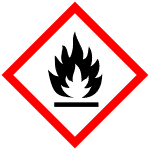镍(II)溴化乙烯二醇二甲基醚络合物, 99%,Nickel(II) bromide ethylene glycol dimethyl ether complex
产品编号:西域试剂-WR366570| CAS NO:28923-39-9| MDL NO:MFCD00013480| 分子式:C4H10O2Br2Ni| 分子量:308.62
本网站销售的所有产品仅用于工业应用或者科学研究等非医疗目的,不可用于人类或动物的临床诊断或者治疗,非药用,非食用,
| 英文名称 | Nickel(II) bromide ethylene glycol dimethyl ether complex |
|---|---|
| CAS编号 | 28923-39-9 |
| 产品闪点 | 124 °F |
| 精确质量 | 305.84000 |
| PSA | 18.46000 |
| LogP | 1.97040 |
| 外观性状 | 固体;Yellow to Amber to Dark red powder to crystal |
| 稳定性 | 遵照规定使用和储存则不会分解。 |
| 储存条件 | 保持贮藏器密封 放入紧密的贮藏器内,储存在阴凉,干燥的地方 |
相关文档
化学品安全说明书(MSDS)
下载MSDS质检证书(COA)
相关产品
| 符号 |


GHS02, GHS07 |
|---|---|
| 信号词 | Danger |
| 危害声明 | H228-H302-H312-H315-H319-H332-H335 |
| 警示性声明 | P210-P261-P280-P305 + P351 + P338 |
| 个人防护装备 | dust mask type N95 (US);Eyeshields;full-face particle respirator type N100 (US);Gloves;respirator cartridge type N100 (US);type P1 (EN143) respirator filter;type P3 (EN 143) respirator cartridges |
| 危害码 (欧洲) | F: Flammable;Xn: Harmful; |
| 风险声明 (欧洲) | 11-20/21/22-36/37/38 |
| 安全声明 (欧洲) | 16-22-26-36/37/39-45 |
| 危险品运输编码 | UN 1325 4.1/PG 2 |
|
Section 1: Product Identification Chemical Name:Nickel(II) bromide, dimethoxyethane adduct, min. 97% CAS Registry Number:28923-39-9 Formula:NiBr2.CH3O(CH2)2OCH3 EINECS Number:none Chemical Family:metal halide Synonym:Nickelous bromide, dimethoxyethane adduct
Section 2: Composition and Information on Ingredients IngredientCAS NumberPercentACGIH (TWA)OSHA (PEL) Title compound28923-39-9100%0.1mg/m3 (as Ni)1mg/m3 (as Ni) Section 3: Hazards Identification Toxic if swallowed. Ingestion of nickel salts may cause intestinal disorders, convulsions and asphyxia. Irritating Emergency Overview: to skin, eyes and respiratory tract. May cause cancer and heritable genetic damage. Primary Routes of Exposure:Ingestion, inhalation of dust Eye Contact:Causes slight to mild irritation of the eyes. Skin Contact:Causes slight to mild irritation of the skin. Prolonged exposure to nickel salts may lead to dermatitis. Inhalation:Irritating to the nose, mucous membranes and respiratory tract. May cause sensitization by inhalation. Toxic if swallowed. Ingestion may lead to dizziness, abdominal cramps, vomiting, bloody diarrhea, weakness Ingestion: and convulsions. Toxic if swallowed. Irritating to skin, eyes and respiratory tract. May cause intestinal disorders, convulsions, Acute Health Affects: asphyxia, sensitization dermatitis, allergic asthma and pneumonitis. Prolonged exposure to nickel and nickel compounds may lead to skin irritation and dermatitis. May cause Chronic Health Affects: cancer and heritable genetic damage. Dimethoxyethane may be a teratogen. NTP:Yes IARC:Yes OSHA:No SECTION 4: First Aid Measures Immediately flush the eyes with copious amounts of water for at least 10-15 minutes. A victim may need Eye Exposure: assistance in keeping their eye lids open. Get immediate medical attention. Wash the affected area with water. Remove contaminated clothes if necessary. Seek medical assistance if Skin Exposure: irritation persists. Remove the victim to fresh air. Closely monitor the victim for signs of respiratory problems, such as difficulty Inhalation: in breathing, coughing, wheezing, or pain. In such cases seek immediate medical assistance. Seek medical attention immediately. Keep the victim calm. Give the victim water (only if conscious). Induce Ingestion: vomiting only if directed by medical personnel. SECTION 5: Fire Fighting Measures Flash Point:not applicable Autoignition Temperature:none Explosion Limits:none Extinguishing Medium:None. Material is non-flammable. If this product is involved in a fire, fire fighters should be equipped with a NIOSH approved positive pressure Special Fire Fighting Procedures: self-contained breathing apparatus and full protective clothing. Hazardous Combustion andIf involved in a fire, this material may emit toxic fumes of hydrogen bromide. Decomposion Products: Unusual Fire or Explosion Hazards: No unusual fire or explosion hazards. SECTION 6: Accidental Release Measures Small spills may be mixed with diatomaceous earth, sand, vermiculite or other suitable inert material and Spill and Leak Procedures: swept up. Avoid raising dust. SECTION 7: Handling and Storage Store the material in a tightly sealed container away from moisture. Handle in a fume hood under a dry Handling and Storage: atmosphere of argon or nitrogen. Prolonged exposure to the atmosphere may degrade the product. SECTION 8: Exposure Controls and Personal Protection Eye Protection:Always wear approved safety glasses when handling a chemical substance in the laboratory. Skin Protection:Wear protective clothing and gloves. Ventilation:Handle the material in an efficient fume hood. If ventilation is not available a respirator should be worn. The use of respirators requires a Respirator Respirator: Protection Program to be in compliance with 29 CFR 1910.134. Ventilation:Handle the material in an efficient fume hood. Additional Protection:No additional protection required. SECTION 9: Physical and Chemical Properties Color and Form:peach powder Molecular Weight:308.62 Melting Point:no data Boiling Point:no data Vapor Pressure:no data Specific Gravity:no data Odor:none Solubility in Water:soluble SECTION 10: Stability and Reactivity Stability:moisture sensitive Hazardous Polymerization:no hazardous polymerization Conditions to Avoid:contact with moisture Incompatibility:active metals and chlorine Decomposition Products:Nickel oxybromide, hydrogen bromide, carbon dioxide, carbon monoxide, organic fumes SECTION 11: Toxicological Information RTECS Data:No information available in the RTECS files. Carcinogenic Effects:Carcinogen (as Ni) Mutagenic Effects:no data Tetratogenic Effects:no data SECTION 12: Ecological Information Ecological Information:No information available SECTION 13: Disposal Considerations Disposal:Dispose of according to local, state and federal regulations. SECTION 14: Transportation Shipping Name (CFR):Toxic solid, Inorganic, N.O.S. Hazard Class (CFR):6.1 Additional Hazard Class (CFR):NA Packaging Group (CFR):III UN ID Number (CFR):UN# 3288 Shipping Name (IATA):Toxic solid, Inorganic, N.O.S. Hazard Class (IATA):6.1 Additional Hazard Class (IATA):NA Packaging Group (IATA):III UN ID Number (IATA):UN# 3288 SECTION 15: Regulatory Information TSCA:Not listed in the TSCA inventory SARA (Title 313):Title compound: See Category Code N495 for reporting. Second Ingredient:none SECTION 16 - ADDITIONAL INFORMATION N/A |









 浙公网安备 33010802013016号
浙公网安备 33010802013016号